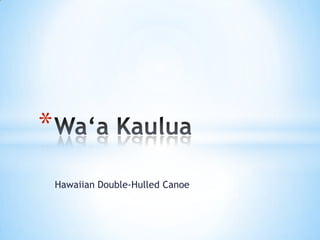
Wa‘a kaulua
- 1. * Hawaiian Double-Hulled Canoe
- 2. * Ia wa‘a nui (That large canoe) Ia wa‘a kialoa (That long canoe) Ia wa‘a peleleu (That broad canoe) A lele mämala (Let chips fly) A manu o uka (The bird of the upland) A manu o kai (The bird of the lowland) ‘I‘iwi pölena (The red Hawaiian honeycreeper) A kau ka hökü (The stars hang above) A kau i ka malama (The daylight arrives) A pae i kula (Bring [the canoe] ashore) * ‘ämama, ua noa (‘ämama, the kapu is lifted) oli
- 3. * "Mau Piailug is from the island of Satawal. It's a mile and a half long and a mile wide. Population 600. Navigation's not about cultural revival, it's about survival. Not enough food can be produced on a small island like that. Their navigators have to go out to sea to catch fish so they can eat." — Nainoa Thompson * movie
- 4. Parts of Wa'a Kaulua
- 5. * Tools: * Ko‘i (adze) 'ana: pumice; used for rubbing * 'eleku: coarse basalt; used as a polishing stone * 'oahi or ola'i: rough stone, pumice, or coral rock for polishing * 'o'io: close-grained basalt; used for polishing * pohaku 'anai wa'a: finishing stones * pohaku pao: stone chisels * pohaku kapili wa'a: stone hammer used to tap chisels in making lashing holes in canoe parts * puki'i wa'a: wooden clamps * puna: fine coral; used for rubbing * wili: drill * Plants: * olona: lashing * 'ie'ie: lashing * niu: sennit, water-sealant * hala: sails, covers * ipu: bailer * koa: hull, manu, seats, gunnels, spar, mast, paddles * 'ulu: hull, manu, gunnels, seats, caulking * kukui: hulls, paint * Plants and Tools Used for Building Canoes
- 6. * More details
- 7. *
- 8. * You should include a list of proposed materials that you plan on using to construct your wa‘a kaulua. Be sure to write down what materials will be utilized for the specific part of your wa‘a kaulua (e.g. small lauhala mats – sail/pe‘a). This proposed materials list should be typed and included with your wa‘a kaulua blueprint/design. *
- 9. * THINGS TO KEEP IN MIND: Scale (in proportion) Appropriate materials (creativity/resourcefulness counts AND aesthetically authentic) Labels (each part must be labeled with Hawaiian name) Solid construction (use materials that are durable) *
- 10. Product reflects the Poʻokela Mākaukau Hana Hou following 3 2 1 Create 3D model of a Appropriate materials Appropriate materials Inappropriate materials traditional waʻa are selected and are selected and some selected and kaulua. creatively modified in modifications evident. contributed to a ways that made waʻa product that performed look traditional. poorly. All 15 components are Project has all Project has all Project does have all clearly visible and components and all components but all components. properly labeled with components are labeled components are not Hawaiian names. with Hawaiian names. labeled. Waʻa isvisually Great care taken in Construction was Construction appears appealing (maiau) construction process so careful and accurate careless or haphazard. that the structure is for the most part, but 2 Many details need neat, and attractive. or 3 details could have refinement. been refined for a more attractive product. *
- 11. * Waʻa Reflection Questions: Your response should be typed, 12 pt. font, double-spaced. 1. How did you choose the materials you used to make your waʻa? Why do you think our ancestorschose the materials they used to make their waʻa? 2. Choose a Hawaiian value(s) that you used to make your waʻa. Give two examplesof how your value is shown in your creation/completion of your wa‘a and tell me how you could possibly use what you chose in other areas of your life. 3. Choose three parts of your waʻa and tell me what the function of that part of the waʻa is and why it is important to the success of the waʻa. *